Genesis of New Particle Formation Events in a Semi-Urban Location in Eastern Himalayan Foothills
Abstract
1. Introduction
2. Methodology
2.1. Observation Site
2.2. Instrumentation and Data
2.3. Satellite Data
2.4. Estimation of Coagulation Loss (Fcoag), Condensation Sink (CondS), and Particle Growth Rate (GR)
3. Results and Discussion
3.1. Average Diurnal Variation of Number Concentration and Geometric Mean Diameter (GMD)
3.2. Identification of NPF Events
3.3. Characterisation of One of the NPF Events
3.3.1. Variation of Number Concentration (Ntotal) with a Geometric Mean Diameter (GMD)
3.3.2. Variation of Coagulation Loss (Fcoag), Condensation Sink (CondS) in Different Mode Regimes and Growth Rate (GR)
3.3.3. Statistical Interpretation of NPF Parameters
| Location | Location Type | Measurement Period | Instrument | Size Range (nm) | CondS (10−3 s−1) | GR (nm/hr) | Ref |
|---|---|---|---|---|---|---|---|
| Lanzhou, China | Suburban | June–July 2006 | DMA | 10–500 | 9.0–24.0 | 1.4–16.9 | [66] |
| Vavihill, Sweden | Rural | February–May 2001–2004 | DMPS | 3–900 | 5.4 | 2.5 | [67] |
| Egbert, Canada | Rural | June–July 2007 | FMPS + SMPS | 14–1000 | 07 ± 0.5 | 5.1 | [62] |
| Hyytiala, Finland | Forest rural | October 2010–September 2011 | DMPS + PSM + CPCB + NAIS + AIS + BSMA | 0.9–1000, | ND | 1.4 | [15] |
| Shanghai, China | Urban | November 2013–January 2014 | nCNC + SMPS | 1.34–3, 14–615 | 27.0 | 2.3 | [68] |
| India (Delhi, New delhi Pune, Hyerabad) | Urban | November–December 2011, 1–7 November 2016 March–May 2012, April–June 2019 | SMPS, DMPS, NAIS + SMPS, nCNC + SMPS | 9–245, 10–800, 3.85–47.8, 1–514 | 60.0, 60–170 6.6 ± 1.5, 17 ± 16.5 | 3.9, 1.6–30 7.4 ± 1.4, 2.2 ± 1.7 | [36], [65], [69], [39] |
| India (Solapur, Gadanki) | Semi-urban/ Semi-rural | August 2018–January 2019, May–July 2012 | SMPS, WRAS | 15–700, 5–32 | 16.4 ± 6, 7.1 ± 4.6 | 1.2–13.8, 4.1 ±2.0 | [36], [32] |
| India (Mahabaleshwar, Mukteshwar, Ranichauri, Hanle) | Mountain | October–November 2014, November 2005–January 2010, December 2016–September 2018, August 2010 | WRAS, DMPS, DMPS, SMPS | 5–32, 10–800, 10–800, 16–1364 | 15.4 ± 2.6, 7.4 ± 4.3, 8.6 ± 5.8, - | 1.4 ± 0.4, 2.4, 6.7 ± 3.8, 0.1 ±20.0 | [70], [71], [72], [31] |
| India (ICARB-2018) | Cruise | January–February 2018 | SMPS | 10–414 | 19.8 ± 55.0 | 14.4 ± 13.1 | [35] |
| India (Dibrugarh) | Semi-urban | November–December 2016 | SMPS | 10.2–333.8 | 7.2 ± 3.6 | 17.16± 12.29 | present Study |
3.4. NPF Precursor Dynamics
4. Conclusions
Supplementary Materials
Author Contributions
Funding
Institutional Review Board Statement
Informed Consent Statement
Data Availability Statement
Acknowledgments
Conflicts of Interest
References
- Kulmala, M.; Vehkamäki, H.; Petäjä, T.; Dal Maso, M.; Lauri, A.; Kerminen, V.-M.; Birmili, W.; McMurry, P.H. Formation and Growth Rates of Ultrafine Atmospheric Particles: A Review of Observations. J. Aerosol Sci. 2004, 35, 143–176. [Google Scholar] [CrossRef]
- Spracklen, D.V.; Carslaw, K.S.; Kulmala, M.; Kerminen, V.-M.; Mann, G.W.; Sihto, S.-L. The Contribution of Boundary Layer Nucleation Events to Total Particle Concentrations on Regional and Global Scales. Atmos. Chem. Phys. 2006, 6, 5631–5648. [Google Scholar] [CrossRef]
- Kuang, C.; McMurry, P.H.; McCormick, A.V. Determination of Cloud Condensation Nuclei Production from Measured New Particle Formation Events. Geophys. Res. Lett. 2009, 36, L09822. [Google Scholar] [CrossRef]
- Asmi, E.; Kivekäs, N.; Kerminen, V.-M.; Komppula, M.; Hyvärinen, A.-P.; Hatakka, J.; Viisanen, Y.; Lihavainen, H. Secondary New Particle Formation in Northern Finland Pallas Site between the Years 2000 and 2010. Atmos. Chem. Phys. 2011, 11, 12959–12972. [Google Scholar] [CrossRef]
- Yue, D.L.; Hu, M.; Zhang, R.Y.; Wu, Z.J.; Su, H.; Wang, Z.B.; Peng, J.F.; He, L.Y.; Huang, X.F.; Gong, Y.G.; et al. Potential Contribution of New Particle Formation to Cloud Condensation Nuclei in Beijing. Atmos. Environ. 2011, 45, 6070–6077. [Google Scholar] [CrossRef]
- Laakso, L.; Merikanto, J.; Vakkari, V.; Laakso, H.; Kulmala, M.; Molefe, M.; Kgabi, N.; Mabaso, D.; Carslaw, K.S.; Spracklen, D.V.; et al. Boundary Layer Nucleation as a Source of New CCN in Savannah Environment. Atmos. Chem. Phys. 2013, 13, 1957–1972. [Google Scholar] [CrossRef]
- Yu, H.; Ortega, J.; Smith, J.N.; Guenther, A.B.; Kanawade, V.P.; You, Y.; Liu, Y.; Hosman, K.; Karl, T.; Seco, R.; et al. New Particle Formation and Growth in an Isoprene-Dominated Ozark Forest: From Sub-5 Nm to CCN-Active Sizes. Aerosol Sci. Technol. 2014, 48, 1285–1298. [Google Scholar] [CrossRef]
- Rose, C.; Sellegri, K.; Moreno, I.; Velarde, F.; Ramonet, M.; Weinhold, K.; Krejci, R.; Andrade, M.; Wiedensohler, A.; Ginot, P.; et al. CCN Production by New Particle Formation in the Free Troposphere. Atmos. Chem. Phys. 2017, 17, 1529–1541. [Google Scholar] [CrossRef]
- Kerminen, V.-M.; Chen, X.; Vakkari, V.; Petäjä, T.; Kulmala, M.; Bianchi, F. Atmospheric New Particle Formation and Growth: Review of Field Observations. Environ. Res. Lett. 2018, 13, 103003. [Google Scholar] [CrossRef]
- Spracklen, D.V.; Carslaw, K.S.; Kulmala, M.; Kerminen, V.-M.; Sihto, S.-L.; Riipinen, I.; Merikanto, J.; Mann, G.W.; Chipperfield, M.P.; Wiedensohler, A.; et al. Contribution of Particle Formation to Global Cloud Condensation Nuclei Concentrations. Geophys. Res. Lett. 2008, 35, L06808. [Google Scholar] [CrossRef]
- Merikanto, J.; Spracklen, D.V.; Mann, G.W.; Pickering, S.J.; Carslaw, K.S. Impact of Nucleation on Global CCN. Atmos. Chem. Phys. 2009, 9, 8601–8616. [Google Scholar] [CrossRef]
- Westervelt, D.M.; Pierce, J.R.; Adams, P.J. Analysis of Feedbacks between Nucleation Rate, Survival Probability and Cloud Condensation Nuclei Formation. Atmos. Chem. Phys. 2014, 14, 5577–5597. [Google Scholar] [CrossRef]
- Gordon, H.; Kirkby, J.; Baltensperger, U.; Bianchi, F.; Breitenlechner, M.; Curtius, J.; Dias, A.; Dommen, J.; Donahue, N.M.; Dunne, E.M.; et al. Causes and Importance of New Particle Formation in the Present-Day and Preindustrial Atmospheres: Causes and Role of New Particle Formation. J. Geophys. Res. Atmos. 2017, 122, 8739–8760. [Google Scholar] [CrossRef]
- Kulmala, M.; Pirjola, L.; Mäkelä, J.M. Stable Sulphate Clusters as a Source of New Atmospheric Particles. Nature 2000, 404, 66–69. [Google Scholar] [CrossRef] [PubMed]
- Kulmala, M.; Petäjä, T.; Nieminen, T.; Sipilä, M.; Manninen, H.E.; Lehtipalo, K.; Dal Maso, M.; Aalto, P.P.; Junninen, H.; Paasonen, P.; et al. Measurement of the Nucleation of Atmospheric Aerosol Particles. Nat. Protoc. 2012, 7, 1651–1667. [Google Scholar] [CrossRef]
- Kerminen, V.-M.; Lehtinen, K.E.J.; Anttila, T.; Kulmala, M. Dynamics of Atmospheric Nucleation Mode Particles: A Timescale Analysis. Tellus B Chem. Phys. Meteorol. 2004, 56, 135. [Google Scholar] [CrossRef]
- McMurry, P.H.; Friedlander, S.K. New Particle Formation in the Presence of an Aerosol. Atmos. Environ. 1979, 13, 1635–1651. [Google Scholar] [CrossRef]
- Kulmala, M.; Lehtinen, K.E.J.; Laaksonen, A. Cluster Activation Theory as an Explanation of the Linear Dependence between Formation Rate of 3nm Particles and Sulphuric Acid Concentration. Atmos. Chem. Phys. 2006, 6, 787–793. [Google Scholar] [CrossRef]
- McMurry, P.H.; Fink, M.; Sakurai, H.; Stolzenburg, M.R.; Mauldin, R.L.; Smith, J.; Eisele, F.; Moore, K.; Sjostedt, S.; Tanner, D.; et al. A Criterion for New Particle Formation in the Sulfur-Rich Atlanta Atmosphere. J. Geophys. Res. 2005, 110, D22S02. [Google Scholar] [CrossRef]
- Coakley, J. Reflections on Aerosol Cooling. Nature 2005, 438, 1091–1092. [Google Scholar] [CrossRef]
- Ball, S.M.; Hanson, D.R.; Eisele, F.L.; McMurry, P.H. Laboratory Studies of Particle Nucleation: Initial Results for H 2 SO 4, H 2 O, and NH 3 Vapors. J. Geophys. Res. Atmos. 1999, 104, 23709–23718. [Google Scholar] [CrossRef]
- Almeida, J.; Schobesberger, S.; Kürten, A.; Ortega, I.K.; Kupiainen-Määttä, O.; Praplan, A.P.; Adamov, A.; Amorim, A.; Bianchi, F.; Breitenlechner, M.; et al. Molecular Understanding of Sulphuric Acid–Amine Particle Nucleation in the Atmosphere. Nature 2013, 502, 359–363. [Google Scholar] [CrossRef] [PubMed]
- Raes, F. Entrainment of Free Tropospheric Aerosols as a Regulating Mechanism for Cloud Condensation Nuclei in the Remote Marine Boundary Layer. J. Geophys. Res. 1995, 100, 2893. [Google Scholar] [CrossRef]
- Kirkby, J.; Curtius, J.; Almeida, J.; Dunne, E.; Duplissy, J.; Ehrhart, S.; Franchin, A.; Gagné, S.; Ickes, L.; Kürten, A.; et al. Role of Sulphuric Acid, Ammonia and Galactic Cosmic Rays in Atmospheric Aerosol Nucleation. Nature 2011, 476, 429–433. [Google Scholar] [CrossRef] [PubMed]
- Seinfeld, J.H.; Pandis, S.N. Atmospheric Chemistry and Physics: From Air Pollution to Climate Change, 2nd ed.; John Wiley & Sons: New York, NY, USA, 2006. [Google Scholar]
- Arlander, D.W. The Tropospheric Distribution of Formaldehyde During TROPOZ II. J. Atmos. Chem. 1995, 22, 251–268. [Google Scholar] [CrossRef]
- Kanawade, V.P.; Tripathi, S.N.; Chakraborty, A.; Yu, H. Chemical Characterization of Sub-Micron Aerosols during New Particle Formation in an Urban Atmosphere. Aerosol Air Qual. Res. 2020, 20, 1294–1305. [Google Scholar] [CrossRef]
- Bates, E.D.; Mayton, R.D.; Ntai, I.; Davis, J.H. CO2 Capture by a Task-Specific Ionic Liquid. J. Am. Chem. Soc. 2002, 124, 926–927. [Google Scholar] [CrossRef]
- O’Dowd, C.D.; Hoffmann, T. Coastal New Particle Formation: A Review of the Current State-Of-The-Art. Environ. Chem. 2005, 2, 245. [Google Scholar] [CrossRef]
- Kanawade, V.P.; Tripathi, S.N.; Bhattu, D.; Shamjad, P.M. Sub-Micron Particle Number Size Distributions Characteristics at an Urban Location, Kanpur, in the Indo-Gangetic Plain. Atmos. Res. 2014, 147–148, 121–132. [Google Scholar] [CrossRef]
- Kompalli, S.K.; Suresh Babu, S.; Krishna Moorthy, K.; Gogoi, M.M.; Nair, V.S.; Chaubey, J.P. The Formation and Growth of Ultrafine Particles in Two Contrasting Environments: A Case Study. Ann. Geophys. 2014, 32, 817–830. [Google Scholar] [CrossRef]
- Kanawade, V.P.; Shika, S.; Pöhlker, C.; Rose, D.; Suman, M.N.S.; Gadhavi, H.; Kumar, A.; Nagendra, S.M.S.; Ravikrishna, R.; Yu, H.; et al. Infrequent Occurrence of New Particle Formation at a Semi-Rural Location, Gadanki, in Tropical Southern India. Atmos. Environ. 2014, 94, 264–273. [Google Scholar] [CrossRef]
- Sarangi, B.; Aggarwal, S.G.; Gupta, P.K. A Simplified Approach to Calculate Particle Growth Rate Due to Self-Coagulation, Scavenging and Condensation Using SMPS Measurements during a Particle Growth Event in New Delhi. Aerosol Air Qual. Res. 2015, 15, 166–179. [Google Scholar] [CrossRef]
- Kompalli, S.K.; Babu, S.S.; Udayasoorian, C.; Jayabalakrishnan, R.M. Role of Anthropogenic Emissions and Meteorology on Ultrafine Particle Bursts over a High Altitude Site in Western Ghats during Pre-Monsoon. J. Atmos. Sol.-Terr. Phys. 2018, 179, 378–388. [Google Scholar] [CrossRef]
- Kompalli, S.K.; Nair, V.S.; Jayachandran, V.; Gogoi, M.M.; Babu, S.S. Particle Number Size Distributions and New Particle Formation Events over the Northern Indian Ocean during Continental Outflow. Atmos. Environ. 2020, 238, 117719. [Google Scholar] [CrossRef]
- Varghese, M.; Leena, P.P.; Murugavel, P.; Bankar, S.; Todekar, K.; Chowdhuri, S.; Safai, P.D.; Malap, N.; Konwar, M.; Dixit, S.; et al. New Particle Formation Observed from a Rain Shadow Region of the Western Ghats, India. Toxicol. Environ. Chem. 2020, 102, 305–333. [Google Scholar] [CrossRef]
- Laj, P.; Bigi, A.; Rose, C.; Andrews, E.; Lund Myhre, C.; Collaud Coen, M.; Lin, Y.; Wiedensohler, A.; Schulz, M.; Ogren, J.A.; et al. A Global Analysis of Climate-Relevant Aerosol Properties Retrieved from the Network of Global Atmosphere Watch (GAW) near-Surface Observatories. Atmos. Meas. Tech. 2020, 13, 4353–4392. [Google Scholar] [CrossRef]
- Shika, S.; Gadhavi, H.; Suman, M.N.S.; Ravikrishna, R.; Gunthe, S.S. Atmospheric Aerosol Properties at a Semi-Rural Location in Southern India: Particle Size Distributions and Implications for Cloud Droplet Formation. SN Appl. Sci. 2020, 2, 1007. [Google Scholar] [CrossRef]
- Sebastian, M.; Kanawade, V.P.; Pierce, J.R. Observation of Sub-3nm Particles and New Particle Formation at an Urban Location in India. Atmos. Environ. 2021, 256, 118460. [Google Scholar] [CrossRef]
- Kanawade, V.P.; Sebastian, M.; Hooda, R.K.; Hyvärinen, A.-P. Atmospheric New Particle Formation in India: Current Understanding and Knowledge Gaps. Atmos. Environ. 2022, 270, 118894. [Google Scholar] [CrossRef]
- Sebastian, M.; Kompalli, S.K.; Kumar, V.A.; Jose, S.; Babu, S.S.; Pandithurai, G.; Singh, S.; Hooda, R.K.; Soni, V.K.; Pierce, J.R.; et al. Observations of Particle Number Size Distributions and New Particle Formation in Six Indian Locations. Atmos. Chem. Phys. 2022, 22, 4491–4508. [Google Scholar] [CrossRef]
- Ramanathan, V.; Crutzen, P.J.; Lelieveld, J.; Mitra, A.P.; Althausen, D.; Anderson, J.; Andreae, M.O.; Cantrell, W.; Cass, G.R.; Chung, C.E.; et al. Indian Ocean Experiment: An Integrated Analysis of the Climate Forcing and Effects of the Great Indo-Asian Haze. J. Geophys. Res. Atmos. 2001, 106, 28371–28398. [Google Scholar] [CrossRef]
- Tripathi, S.N.; Tare, V.; Chinnam, N.; Srivastava, A.K.; Dey, S.; Agarwal, A.; Kishore, S.; Lal, R.B.; Manar, M.; Kanawade, V.P.; et al. Measurements of Atmospheric Parameters during Indian Space Research Organization Geosphere Biosphere Programme Land Campaign II at a Typical Location in the Ganga Basin: 1. Physical and Optical Properties: Atmospheric Parameters in ig Basin. J. Geophys. Res. Atmos. 2006, 111, D23209. [Google Scholar] [CrossRef]
- Tare, V.; Tripathi, S.N.; Chinnam, N.; Srivastava, A.K.; Dey, S.; Manar, M.; Kanawade, V.P.; Agarwal, A.; Kishore, S.; Lal, R.B.; et al. Measurements of Atmospheric Parameters during Indian Space Research Organization Geosphere Biosphere Program Land Campaign II at a Typical Location in the Ganga Basin: 2. Chemical Properties: Aerosol Chemistry in ig Basin. J. Geophys. Res. Atmos. 2006, 111, D23210. [Google Scholar] [CrossRef]
- Moorthy, K.K.; Satheesh, S.K.; Babu, S.S.; Dutt, C.B.S. Integrated Campaign for Aerosols, Gases and Radiation Budget (ICARB): An Overview. J. Earth Syst. Sci. 2008, 117 (Suppl. 1), 243–262. [Google Scholar] [CrossRef]
- Nair, V.S.; Jayachandran, V.N.; Kompalli, S.K.; Gogoi, M.M.; Babu, S.S. Cloud Condensation Nuclei Properties of South Asian Outflow over the Northern Indian Ocean during Winter. Atmos. Chem. Phys. 2020, 20, 3135–3149. [Google Scholar] [CrossRef]
- Pathak, B.; Kalita, G.; Bhuyan, K.; Bhuyan, P.K.; Moorthy, K.K. Aerosol Temporal Characteristics and Its Impact on Shortwave Radiative Forcing at a Location in the Northeast of India. J. Geophys. Res. 2010, 115, D19204. [Google Scholar] [CrossRef]
- Bharali, C.; Pathak, B.; Kalita, G.; Bhuyan, P.K. Temporal Characteristics of Particulates, Black Carbon and Trace Gases over Dibrugarh, North-East India; IASTA: Mumbai, India, 2012. [Google Scholar]
- Pathak, B.; Bhuyan, P.K.; Gogoi, M.; Bhuyan, K. Seasonal Heterogeneity in Aerosol Types over Dibrugarh-North-Eastern India. Atmos. Environ. 2012, 47, 307–315. [Google Scholar] [CrossRef]
- Pathak, B.; Bhuyan, P.K.; Biswas, J.; Takemura, T. Long Term Climatology of Particulate Matter and Associated Microphysical and Optical Properties over Dibrugarh, North-East India and Inter-Comparison with SPRINTARS Simulations. Atmos. Environ. 2013, 69, 334–344. [Google Scholar] [CrossRef]
- Bhuyan, P.K.; Bharali, C.; Pathak, B.; Kalita, G. The Role of Precursor Gases and Meteorology on Temporal Evolution of O3 at a Tropical Location in Northeast India. Environ. Sci. Pollut. Res. 2014, 21, 6696–6713. [Google Scholar] [CrossRef]
- Pathak, B.; Chutia, L.; Bharali, C.; Bhuyan, P.K. Continental Export Efficiencies and Delineation of Sources for Trace Gases and Black Carbon in North-East India: Seasonal Variability. Atmos. Environ. 2016, 125, 474–485. [Google Scholar] [CrossRef]
- Pathak, B.; Subba, T.; Dahutia, P.; Bhuyan, P.K.; Moorthy, K.K.; Gogoi, M.M.; Babu, S.S.; Chutia, L.; Ajay, P.; Biswas, J.; et al. Aerosol Characteristics in North-East India Using ARFINET Spectral Optical Depth Measurements. Atmos. Environ. 2016, 125, 461–473. [Google Scholar] [CrossRef]
- Pathak, B.; Bhuyan, P.K. Characteristics of Atmospheric Pollutants over the Northeastern Region of India. In Asian Atmospheric Pollution; Elsevier: Amsterdam, The Netherlands, 2022; pp. 367–392. [Google Scholar] [CrossRef]
- Chutia, L.; Ojha, N.; Girach, I.A.; Sahu, L.K.; Alvarado, L.M.A.; Burrows, J.P.; Pathak, B.; Bhuyan, P.K. Distribution of Volatile Organic Compounds over Indian Subcontinent during Winter: WRF-Chem Simulation versus Observations. Environ. Pollut. 2019, 252, 256–269. [Google Scholar] [CrossRef] [PubMed]
- Gogoi, M.M.; Bhuyan, P.K.; Moorthy, K.K. An Investigation of Aerosol Size Distribution Properties at Dibrugarh: North-Eastern India. Terr. Atmos. Ocean. Sci. 2009, 20, 521. [Google Scholar] [CrossRef] [PubMed]
- Dal Maso, M.; Kulmala, M.; Riipinen, I.; Wagner, R.; Hussein, T.; Aalto, P.P.; Lehtinen, K.E.J. Formation and Growth of Fresh Atmospheric Aerosols: Eight Years of Aerosol Size Distribution Data from SMEAR II, Hyytiälä, Finland. Boreal Environ. Res. 2005, 10, 323–336. [Google Scholar]
- Hinds, W.C. Aerosol Technology: Properties, Behavior, and Measurements of Airborne Particles; John Wiley & Sons, Inc.: New York, NY, USA, 1998. [Google Scholar]
- Kanawade, V.P.; Tripathi, S.N.; Singh, D.; Gautam, A.S.; Srivastava, A.K.; Kamra, A.K.; Soni, V.K.; Sethi, V. Observations of New Particle Formation at Two Distinct Indian Subcontinental Urban Locations. Atmos. Environ. 2014, 96, 370–379. [Google Scholar] [CrossRef]
- Kulmala, M.; Maso, M.D.; Mäkela, J.M.; Pirjola, L.; Väkevä, M.; Aalto, P.; Miikkulainen, P.; Hämeri, K.; O’dowd, C.D. On the Formation, Growth and Composition of Nucleation Mode Particles. Tellus B Chem. Phys. Meteorol. 2001, 53, 479. [Google Scholar] [CrossRef]
- Fuchs, N.A.; Sutugin, A.G. High-Dispersed Aerosols. In Topics in Current Aerosol Research; Elsevier: Amsterdam, The Netherlands, 1971; p. 1. [Google Scholar] [CrossRef]
- Jeong, C.-H.; Evans, G.J.; McGuire, M.L.; Chang, R.Y.-W.; Abbatt, J.P.D.; Zeromskiene, K.; Mozurkewich, M.; Li, S.-M.; Leaitch, W.R. Particle Formation and Growth at Five Rural and Urban Sites. Atmos. Chem. Phys. 2010, 10, 7979–7995. [Google Scholar] [CrossRef]
- Chu, B.; Kerminen, V.-M.; Bianchi, F.; Yan, C.; Petäjä, T.; Kulmala, M. Atmospheric New Particle Formation in China. Atmos. Chem. Phys. 2019, 19, 115–138. [Google Scholar] [CrossRef]
- Mäkelä, J.M.; Dal Maso, M.; Pirjola, L. Characteristics of the Atmospheric Particle Formation Events Observed at A Boreal Forest Site in Southern Finland. Boreal Environ. Res. Hels. 2000, 5, 299–313. [Google Scholar]
- Kanawade, V.P.; Srivastava, A.K.; Ram, K.; Asmi, E.; Vakkari, V.; Soni, V.K.; Varaprasad, V.; Sarangi, C. What caused severe air pollution episode of November 2016 in New Delhi? Atmos. Environ. 2019, 222, 117–125. [Google Scholar] [CrossRef]
- Gao, J.; Chai, F.; Wang, T.; Wang, W. Particle Number Size Distribution and New Particle Formation (NPF) in Lanzhou, Western China. Particuology 2011, 9, 611–618. [Google Scholar] [CrossRef]
- Kristensson, A.; Maso, M.D.; Swietlicki, E.; Hussein, T.; Zhou, J.; Kerminen, V.-M.; Kulmala, M. Characterization of New Particle Formation Events at a Background Site in Southern Sweden: Relation to Air Mass History. Tellus B Chem. Phys. Meteorol. 2008, 60, 330. [Google Scholar] [CrossRef]
- Xiao, S.; Wang, M.Y.; Yao, L.; Kulmala, M.; Zhou, B.; Yang, X.; Chen, J.M.; Wang, D.F.; Fu, Q.Y.; Worsnop, D.R.; et al. Strong Atmospheric New Particle Formation in Winter in Urban Shanghai, China. Atmos. Chem. Phys. 2015, 15, 1769–1781. [Google Scholar] [CrossRef]
- Kamra, A.K.; Siingh, D.; Gautam, A.S.; Kanawade, V.P.; Tripathi, S.N.; Srivastava, A.K. Atmospheric Ions and New Particle Formation Events at a Tropical Location, Pune, India. Q. J. R. Meteorol. Soc. 2015, 141, 3140–3156. [Google Scholar] [CrossRef]
- Leena, P.P.; Anil Kumar, V.; Dani, K.K.; Sombawne, S.M.; Murugavel, P.; Pandithurai, G. Evidence of New Particle Formation during Post Monsoon Season over a High-Altitude Site of the Western Ghats, India. Toxicol. Environ. Chem. 2017, 99, 652–664. [Google Scholar] [CrossRef]
- Neitola, K.; Asmi, E.; Komppula, M.; Hyvärinen, A.-P.; Raatikainen, T.; Panwar, T.S.; Sharma, V.P.; Lihavainen, H. New Particle Formation Infrequently Observed in Himalayan Foothills—Why? Atmos. Chem. Phys. 2011, 11, 8447–8458. [Google Scholar] [CrossRef]
- Sebastian, M.; Kanawade, V.P.; Soni, V.K.; Asmi, E.; Westervelt, D.M.; Vakkari, V.; Hyvärinen, A.; Pierce, J.R.; Hooda, R.K. New Particle Formation and Growth to Climate-Relevant Aerosols at a Background Remote Site in the Western Himalaya. J. Geophys. Res. Atmos. 2021, 126, e2020JD03326. [Google Scholar] [CrossRef]
- Subba, T.; Pathak, B.; Gogoi, M.M.; Ajay, P.; Dahutia, P.; Chakraborty, A.; Bhuyan, P.K. Observations on the decadal variability of aerosol in eastern Himalayan foothills: Evidence of an anthropologically induced positive shift. Atmos. Environ. 2023, 299, 119638. [Google Scholar] [CrossRef]
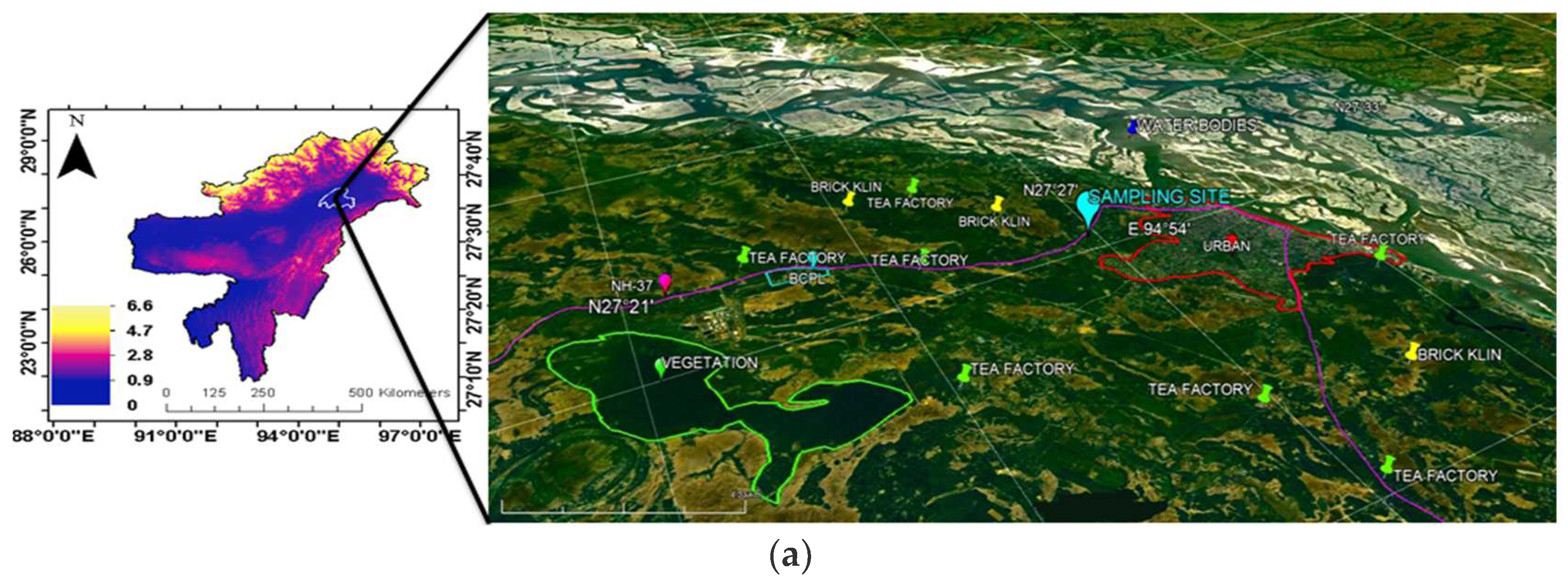


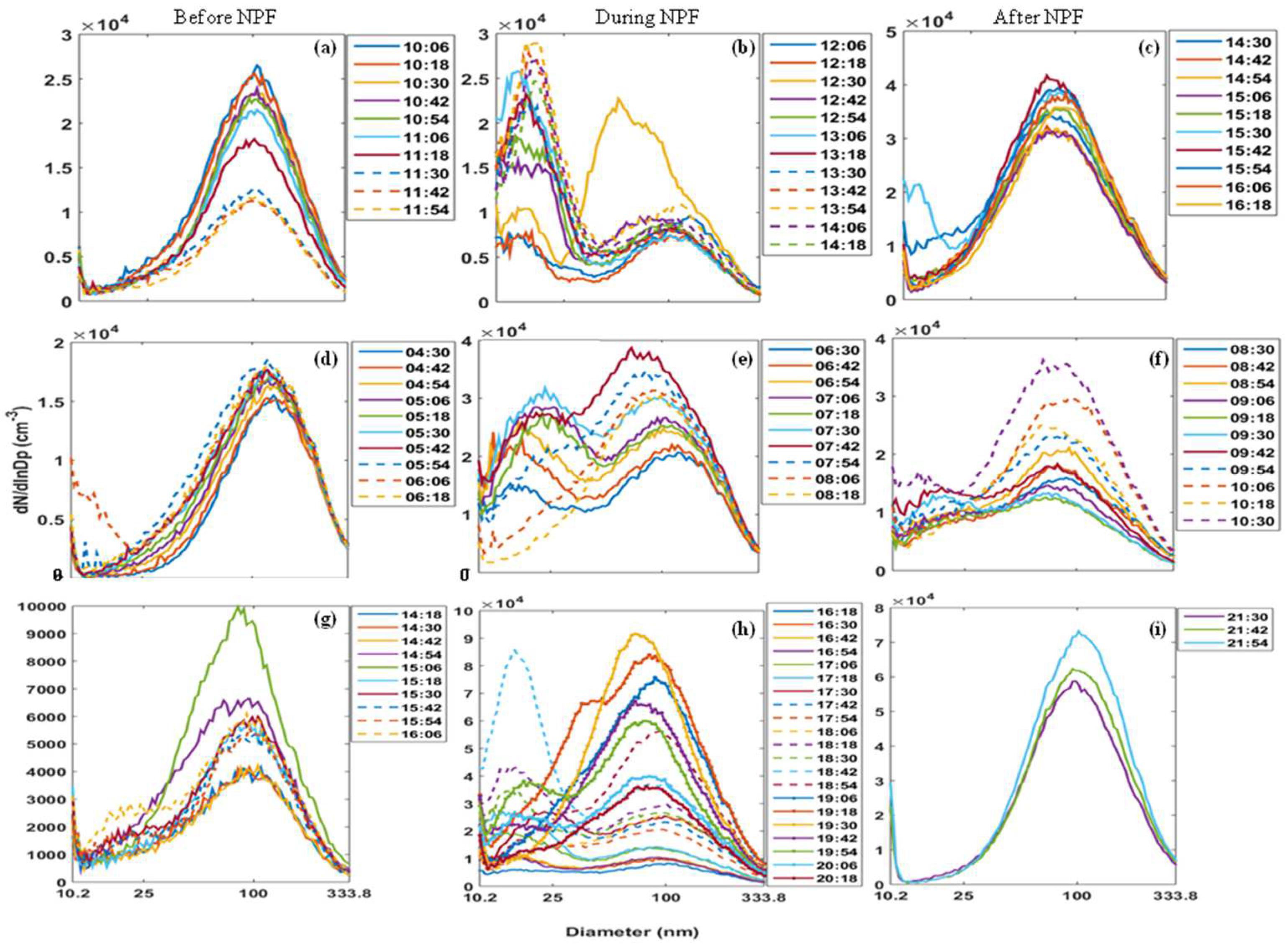
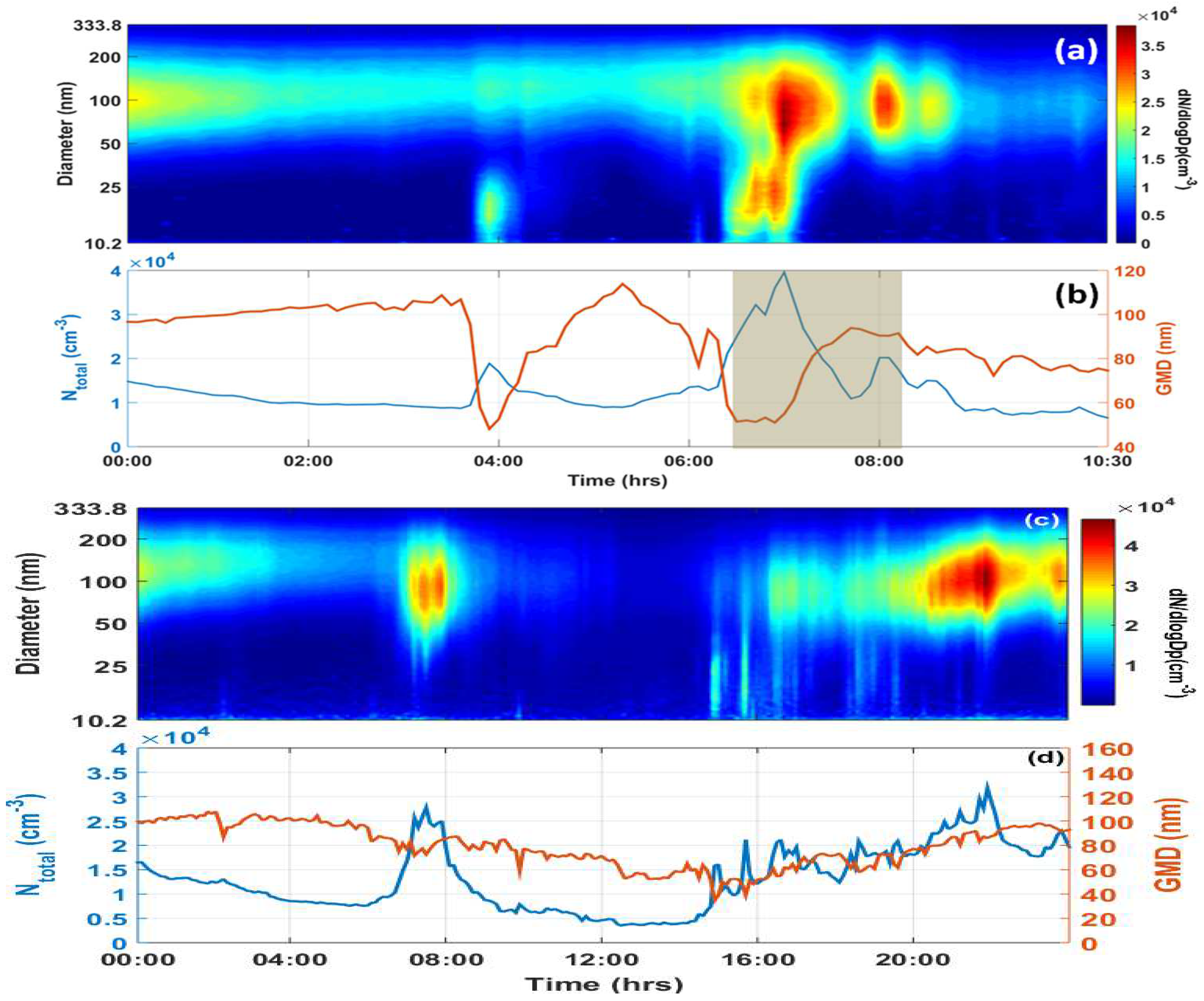
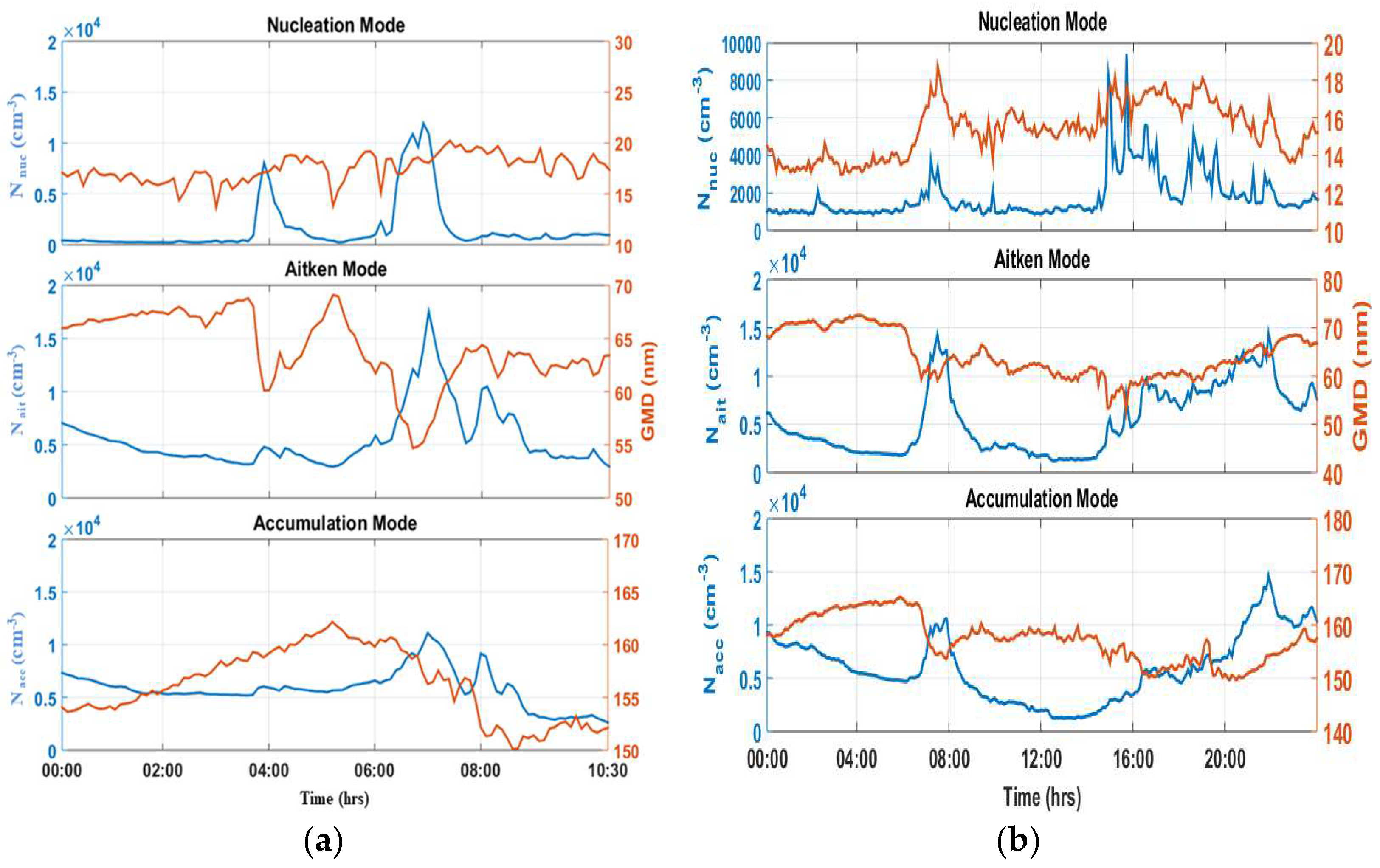
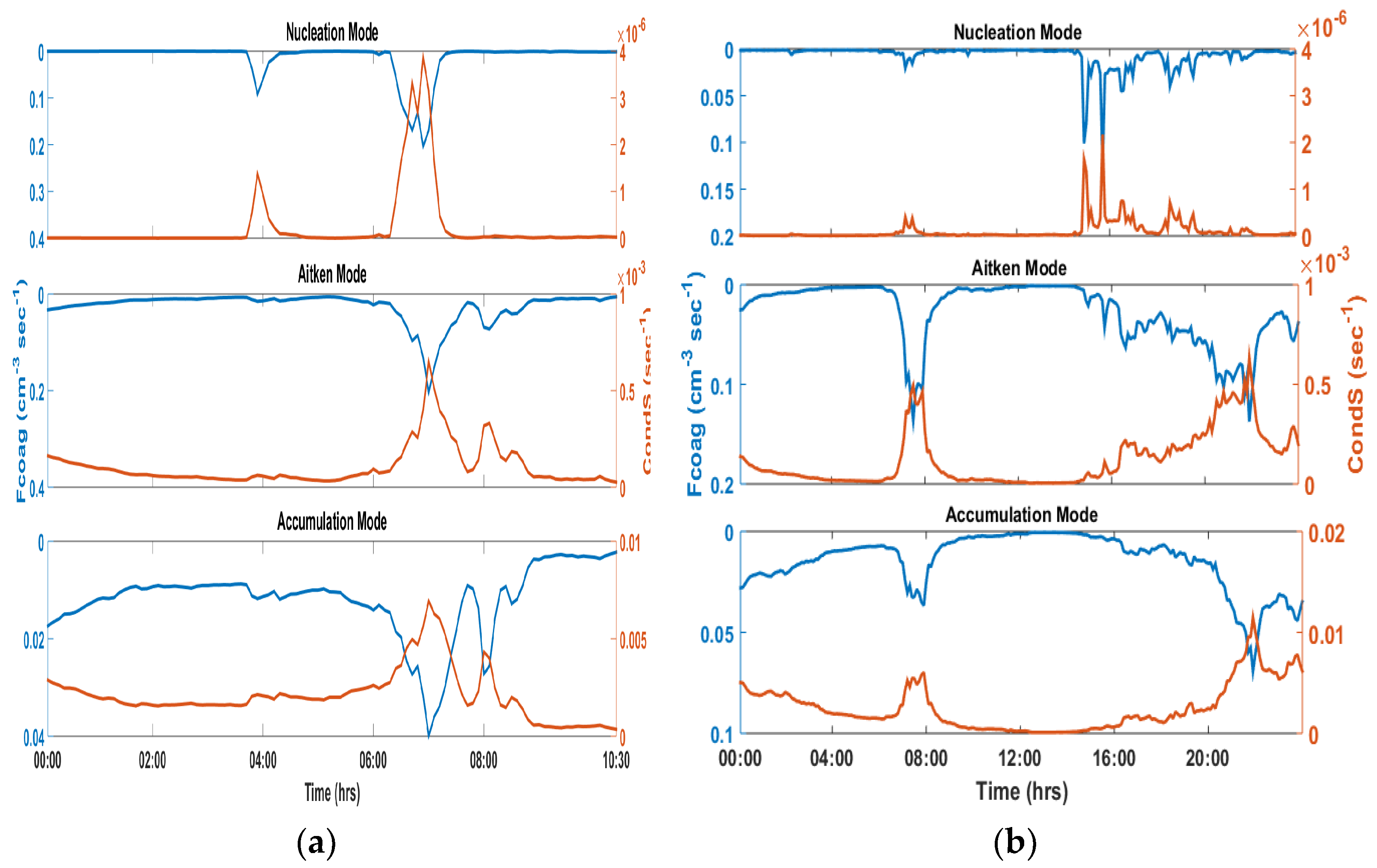

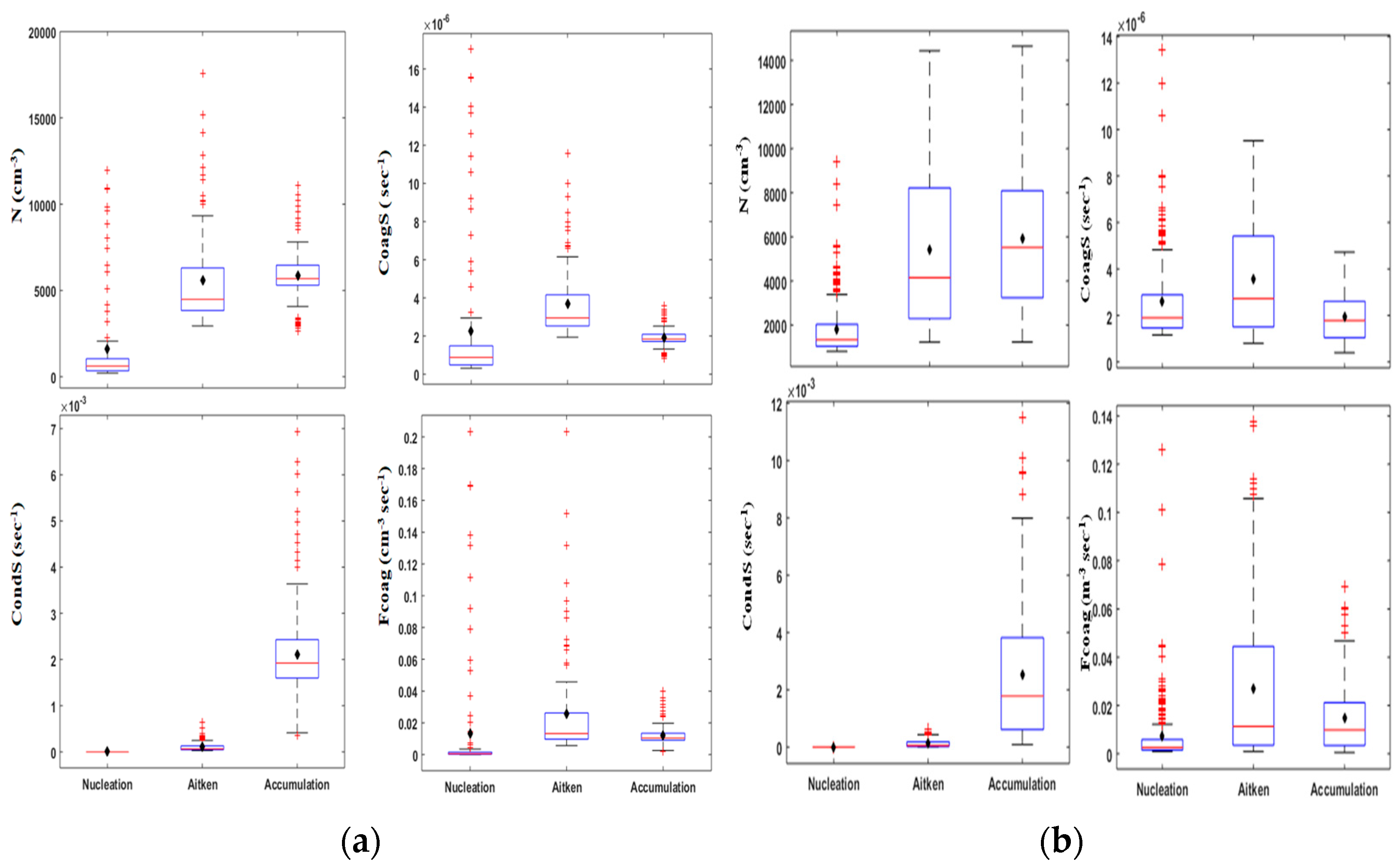
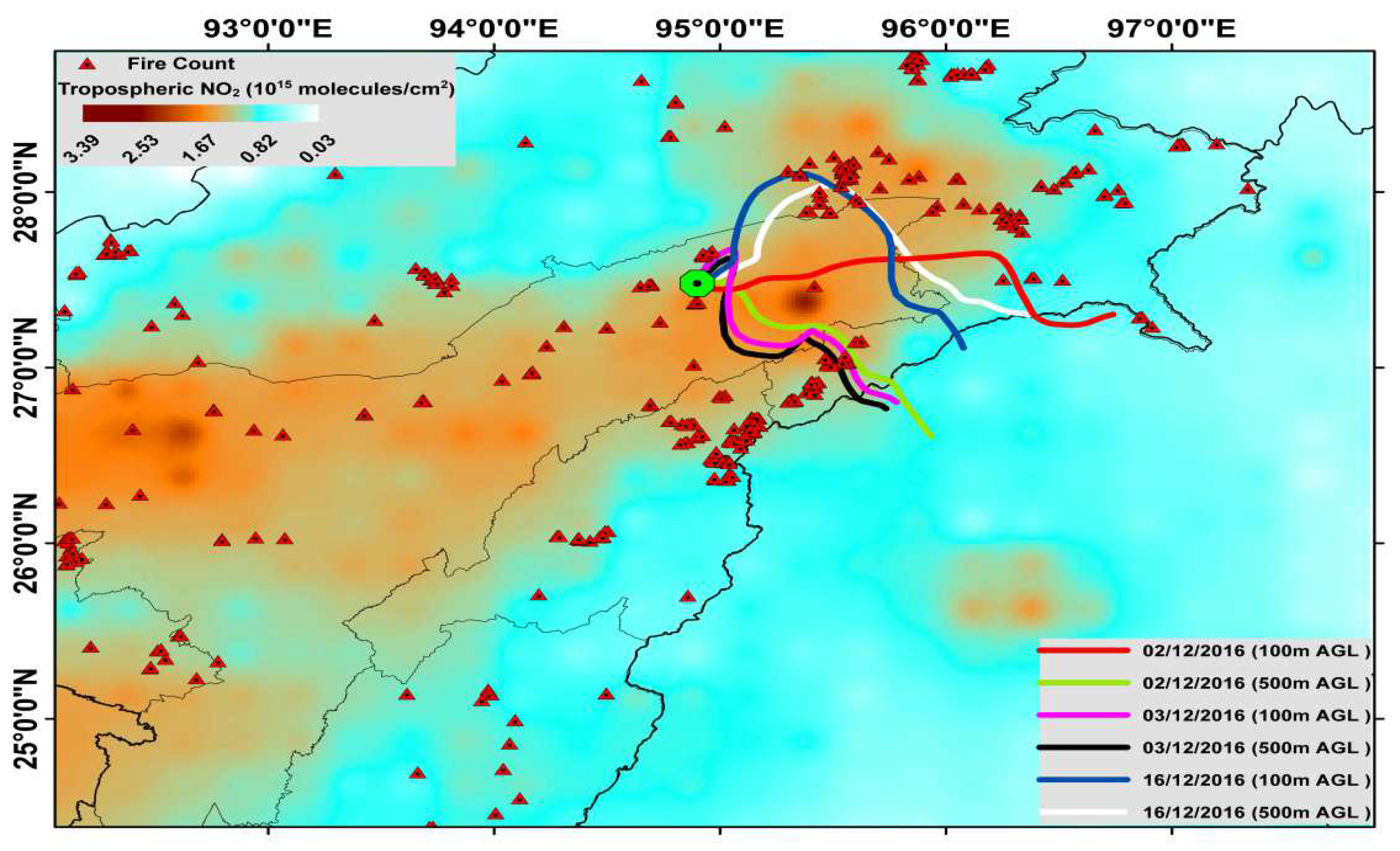
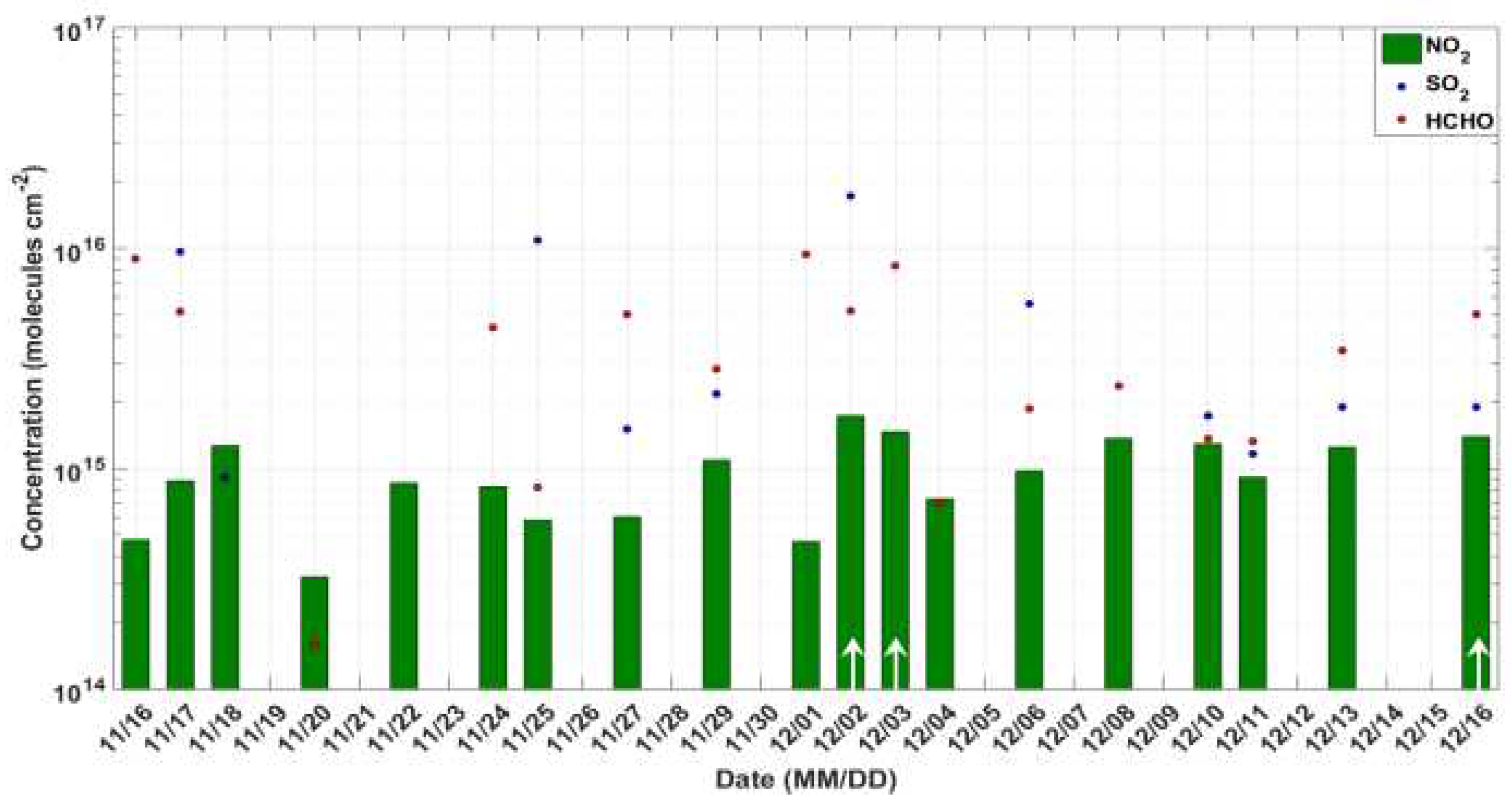
| Date (2016) | Ntotal (104 cm−3) | GMD (nm) | CoagStotal (10−4 s−1) | CondStotal (10−3 s−1) | Fcoagtotal (cm−3 s−1) | GR (nm/hr) |
|---|---|---|---|---|---|---|
| 2 December | 2.09 ± 1.29 | 60.72 ± 18.59 | 2.28 ± 1.40 | 8.20 ± 1.18 | 6.58 ± 7.55 | 13 |
| 3 December | 1.30 ± 0.63 | 88.56 ± 16.32 | 1.42 ± 0.69 | 3.20 ± 2.12 | 2.29 ± 2.85 | 31 |
| 16 December | 1.88 ± 1.60 | 81.20 ± 23.71 | 2.06 ± 1.75 | 10.2 ± 13.1 | 6.69 ± 9.89 | 7.5 |
Disclaimer/Publisher’s Note: The statements, opinions and data contained in all publications are solely those of the individual author(s) and contributor(s) and not of MDPI and/or the editor(s). MDPI and/or the editor(s) disclaim responsibility for any injury to people or property resulting from any ideas, methods, instructions or products referred to in the content. |
© 2023 by the authors. Licensee MDPI, Basel, Switzerland. This article is an open access article distributed under the terms and conditions of the Creative Commons Attribution (CC BY) license (https://creativecommons.org/licenses/by/4.0/).
Share and Cite
Das, B.; Pathak, B.; Chutia, L.; Subba, T.; Bhuyan, P.K. Genesis of New Particle Formation Events in a Semi-Urban Location in Eastern Himalayan Foothills. Atmosphere 2023, 14, 795. https://doi.org/10.3390/atmos14050795
Das B, Pathak B, Chutia L, Subba T, Bhuyan PK. Genesis of New Particle Formation Events in a Semi-Urban Location in Eastern Himalayan Foothills. Atmosphere. 2023; 14(5):795. https://doi.org/10.3390/atmos14050795
Chicago/Turabian StyleDas, Barlin, Binita Pathak, Lakhima Chutia, Tamanna Subba, and Pradip Kumar Bhuyan. 2023. "Genesis of New Particle Formation Events in a Semi-Urban Location in Eastern Himalayan Foothills" Atmosphere 14, no. 5: 795. https://doi.org/10.3390/atmos14050795
APA StyleDas, B., Pathak, B., Chutia, L., Subba, T., & Bhuyan, P. K. (2023). Genesis of New Particle Formation Events in a Semi-Urban Location in Eastern Himalayan Foothills. Atmosphere, 14(5), 795. https://doi.org/10.3390/atmos14050795







